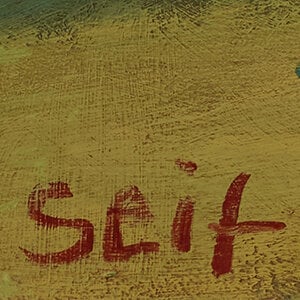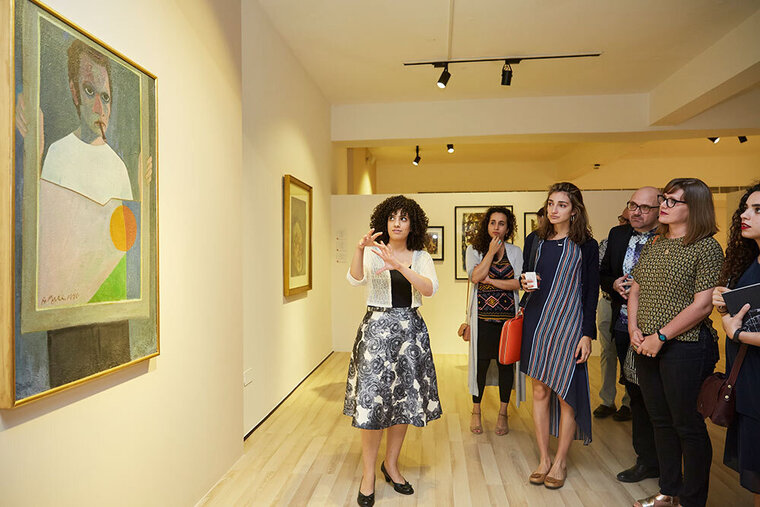


Last updated on Fri 14 October, 2016


BELOVED BODIES
October 14 2016 - February 1 2017
BARJEEL ART FOUNDATION
Opening today: The Barjeel Art Foundation presents Beloved Bodies, Part 1, at Barjeel Art Foundation Gallery, Maraya Art Centre, Sharjah Inspired by French philosopher Roland Barthes, the exhibition challenges social conventions of the body and presents over 30 works by 23 artists across the Arab world
Part 1: 14 October 2016 - 1 February 2017
Opening Reception: 14 October, 5pm
Part 2: March – September 2017
Today the Barjeel Art Foundation opens a new exhibition at the Barjeel Art Foundation Gallery at the Maraya Art Centre, Sharjah. Beloved Bodies, showcasing a variety of depictions of the human form, from the 20th century to the present day, is comprised of two phases: Part 1 (October 2016 - February 2017) and Part 2 (March 2017 – September 2017). The exhibition aims to challenge social expectations and conventions of how the body should be perceived, used and represented across the world. The image of the body not only moves between figuration and abstraction, but also from an object of desire, affection and observation, to an active, self-conscious figure that observes, seeks and confronts the viewer’s gaze. Beloved Bodies is presented and curated by Barjeel Art Foundation curator Mandy Merzaban, with works drawn exclusively from the Barjeel Art Collection, one of the most extensive collections of Modern and Contemporary Arab art from the region, dating from the 1800s to the present day. Established by Sultan Sooud Al-Qassemi in 2010, the collection forms the basis for examining the history and significance of Arab art from its early modernist beginnings to the contemporary work created by Arab artists both locally and on a global stage. Through in-house exhibitions (in Sharjah), lending work to cultural organisations across the world, and partnerships with arts institutions internationally, the foundation strives to convey the nuances inherent to Arab histories beyond the borders of culture and geography, and encourage public awareness of the importance of art to the community. The exhibition’s title, Beloved Bodies, is taken from the writings of the French philosopher Roland Barthes: the term ‘beloved body’ recurs through his writings on love to describe the object of a lover’s affection. Inspired by the universal themes of love and desire, which are continuously debated across the world through philosophy, literature, music and art, Beloved Bodies examines how these are translated through representations of the human figure, through works by Arab artists across the world. The diverse range of works featured in Beloved Bodies offers a wide scope for reading the different sides of love and desire and highlights the spectrum of thrills and frustrations, aspirations and shortcomings associated with the imminence of internal longing. Many works, such as contemporary Emirati artist Mohammed Kazem’s Tongue (1994), part of his performative exploration placing his tongue on banal objects, deal subtly with the body as a sensual instrument. The exhibition also looks at the disconnect between the body and mind - an unbridgeable separation - and explores the ways in which love and separation are embodied through art. Four works by the Syrian artist Marwan Kassab Bachi are presented, ranging from 1965-1990. All portraits, the paintings develop from a stylised portrayal of the Syrian political figure Munif al-Razzaz, to further abstracted works that illustrate the artist’s interest in exploring the human condition and intricacies of the mind through the human head as inspiration.
The exhibition presents a number of key works by influential female artists, including Lebanese- American artist Etel Adnan, who presents one of the most abstract works in the exhibition. Alongside this, the late Iraqi artist Layla Attar’s Untitled (1988), killed during the US bombardment in 1993, depicts a lone woman in an ethereal primordial forest that recalls the Epic of Gilgamesh. The Lebanese artist Huguette Caland’s Erotic Composition (1966-67), a small, delicate abstract drawing hangs alone in a
peach coloured room in the exhibition, challenges expectations and continues the artist’s devotion to
subtle representations of the feminine form. This second phase of the exhibition, Beloved Bodies Part 2 opening 1 March, will present a larger selection of contemporary works that include artists Hayv Kahraman and Zoulikha Bouabdellah. The exhibition will include, among others, work by Ghada Amer, a New York-based Egyptian artist who emigrated to France aged 11. Amer will present Snow White Without the Dwarves, an embroidered drawing on canvas that combines painting and needlework. Conjuring up images of hidden desire, beauty and ecstasy, Amer’s purposefully indiscernible fantasy includes famous cartoon depictions of
Snow White embedded within fragmented imagery. In her use of sewing as a craft typically regarded as feminine, Amer threads together outmoded cultural norms with carnal desire.
Mandy Merzaban, Curator at the Barjeel Art Foundation, said: “Beloved Bodies observes the human figure in a way that is guided by the artists’ internal and external experiences. A primary objective of the exhibition is to prompt the viewer to think about the body as part of a different political, social and spiritual arena that is at times at odds with one another.”
For media enquiries including interview requests and full list of works, please contact:
Victoria Mitchell
SUTTON
[email protected]
+44 (0) 207 183 3577
****
Notes to Editors
Barjeel Art Foundation
Barjeel Art Foundation is an independent, UAE-based initiative established to manage, preserve and exhibit an extensive collection of Modern and Contemporary Arab Art. The foundation’s guiding principle is to contribute to the intellectual development of the art scene in the Arab region by building a prominent, publicly accessible art collection in the UAE. Part of this objective involves developing a public platform to foster critical dialogue around contemporary art practices with a focus on artists with Arab heritage internationally. The foundation strives to create an open-ended enquiry that responds to and conveys the nuances inherent to Arab histories beyond borders of culture and geography. By hosting in-house exhibitions, lending artwork to international forums, producing print and online publications, and fashioning interactive public programmes, the foundation strives to serve as an informative resource for contemporary art by Arab artists both locally and on the global stage. In addition to building an informative database of artists, the foundation is seeking to develop an educational programme that both understands and involves the local community. By establishing partnerships with arts and cultural institutions internationally, the foundation looks to create opportunities to encourage public awareness of the importance of art to the community
Join us in our endless discovery of modern and contemporary Arab art